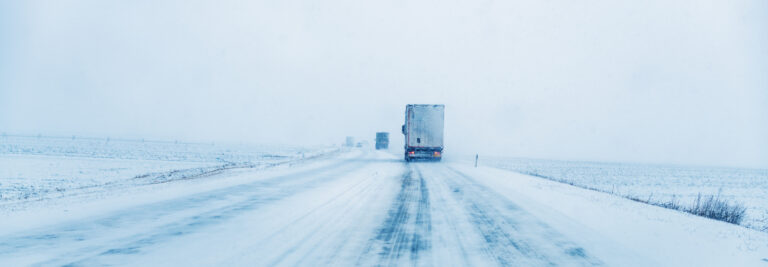Commercial drivers see it all, especially when it comes to bad roads, bad drivers, bad weather and bad traffic.
Winter brings its own set of challenges for commercial drivers. What are the worst winter roads for commercials drivers?
“When it comes to winter driving, the bad tends to get worse, especially in areas with frequent freeze-thaw cycles, heavy snows, and just plain dangerous conditions,” according to Commercial Truck Trader. “Combine this with common winter maintenance issues for trucks and it’s easy to understand why accidents happen more during this season.”
The Big Freeze
Frequent freeze-thaw cycles are particularly prevalent in northern Midwest states such as Michigan, Minnesota and North Dakota. This time of year, there is a regular a chance of snow and ice. When the roads freeze and thaw often it makes a mess out of the pavement. It creates cracks and potholes that can do some serious damage to tires and rattle the drivers.
“Commercial Truck Trader cannot do anything about the conditions of the roads that you drive on or the routes that you are required to take to efficiently get to your drop-off destinations, but we did put together a list of what are considered some of the most dangerous roads to drive on during the winter months,” CTT said. “So, if you happen to see any of these roads through your windshield in the days before spring arrives, please use extra caution and stay alert.”
The Dalton Highway in Alaska
The Dalton Highway runs 414 miles from just north of Fairbanks to Deadhorse, near the Arctic Ocean. While snow, ice, the potential for avalanches, and sub-freezing weather make the trip bad enough, there is a stretch of the road that runs 240 miles with no restaurants, hotels, gas stations, or other convenience services.
“Considering that the average 18-wheeler can roll for about 1,000 miles when fully fueled, the lack of gas stations itself isn’t a big problem,” CTT said. “But you better take along some snacks and extra fluids to stay hydrated, but not so much liquid that you’ll need to make a pitstop along the side of the road, which can be dangerous by itself. You’ll also want to stay alert and keep your fingers crossed for a good five to six hours so that you don’t have any mechanical issues along the way.”
The Million Dollar Highway in Colorado
U.S. Route 550, also known as The Million Dollar Highway, runs approximately 305 miles from Bernalillo, New Mexico to Montrose, Colorado. It can take six hours or more to complete when it’s sunny and warm. In the winter, driving is slowed considerably due to snow, ice, and the risk of avalanches, in addition to steep cliffs and winding roads without guardrails, so drivers need to be extra cautious. Along the way, there are three 10,000-foot mountain passes to navigate, with Red Mountain Pass earning the reputation as the most treacherous of the trio.
“There are some theories why the road is called The Million Dollar Highway,” CTT said. “One theory is that it cost a million dollars to construct the span in the San Juan Mountains from Silverton to Ouray, Colorado, given the treacherous conditions and difficult terrain. A second thought is that the route provides million-dollar views for those who don’t need to keep their eyes on the road. A third idea is that there is a million dollars-worth of gold under the roadbed through the mountains. And the last notion is that people who have driven the road before have said you couldn’t pay them a million dollars to ever drive it again.”
Pacific Coast Highway (PCH) in California
California Highway 1, also known as the Pacific Coast Highway, runs 650-plus miles along the coast of California from Capistrano Beach in Orange County (just south of Irvine and Long Beach) to Leggett in Mendocino County, north of San Francisco. While stretches of highway are among these favorite warm-weather driving destinations for truckers, drivers still have to exercise caution based on the season’s forecast. While California is not particularly prone to winter weather, winter is known as the rainy season in the Golden State. These roads are susceptible to mud and landslides.
U.S. Route 1 in Maine
U.S. Route 1 runs a total of 2,370 miles along the East Coast of the United States, from Key West, Florida to Fort Kent, Maine. But it’s the 526-mile portion in Maine that is particularly dangerous, especially in winter. Dimly lit in many parts, the road is also full of tight curves and prone to fog and slippery conditions year-round because of its proximity to the ocean. However, the threat of moose and large whitetail deer on the road is particularly scary under icy and snowy conditions, especially when whiteouts are making it difficult to see the road ahead.
Even if you drive on all the best roads in America and skip the bad ones, you must be cautious when driving in winter conditions.








